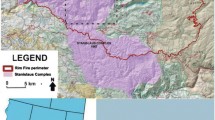Abstract
Mosquito Creek drains a 15.5 km2 watershed on the North Shore Mountains north of Vancouver, British Columbia, Canada, and flows through the densely urbanized District and then City of North Vancouver. Previous studies determined that the creek is subject to debris floods (hyperconcentrated flows). The National Research Council of Canada is applying multi-hazard risk assessment procedures for various regions in B.C. and chose Mosquito Creek as one of its target areas. As part of its natural hazard management plan, the District of North Vancouver (DNV) requested an assessment of debris flood hazards and associated risk to life. Using a combination of empirical methods, dendrochronology and some judgment, BGC Engineering Inc. assessed debris flood hazard extent, velocity and depth for estimated 100-, 200-, 500- and 2,500-year debris flow return periods. Based on the results from the hazard assessment, risk for individuals and groups living within the hazard area, including residential homes and a fire hall, was estimated. Compared to risk tolerance criteria accepted on an interim basis by the DNV, we estimate that societal risk exceeds tolerable standards and that individual risk exceeds tolerable standards for 10 homes. The results from the risk to loss of life study have prompted DNV to implement a series of risk reduction measures including installation of a debris containment net and watershed restoration measures.












Similar content being viewed by others
Notes
Estimated by Roop Smagh (resident) to CBC news (Monday, June 15).
References
Association of Professional Engineers and Geoscientists of British Columbia (APEGBC) (2010) Guidelines for Legislated Landslide Assessments for Proposed Residential Developments in BC. Revised May 2010
Australian Geomechanics Society (AGS) (2007) A national landslide risk management framework for Australia. Aust Geomech 42(1):69
Blown I, Church M (1985) Catastrophic lake drainage within the Homathko River basin, British Columbia. Can Geotech J 22:551–563
Bovis MJ, Dagg BR (1992) Debris flow triggering by impulsive loading: mechanical modeling and case studies. Can Geotech J 29:345–352
Costa JE, Schuster RL (1988) The formation and failure of natural dams. Geol Soc Am Bull 100:1054–1068
FLO-2D Software Inc (2004) FLO-2D users manual version 2004.10, October 2004
Fread DL (1991) BREACH: an erosion model for earthen dam failures. NWS Report, National oceanic and atmospheric administration, Silver Spring, Maryland
Froehlich DC (1995) Peak outflow from breached embankment dam. Journal of Water Resources Planning and Management. J Water Resour Plann Manag 121(1):90–97
Garcia-Martinez R, Lopez JL (2005) Debris flows of December 1999 in Venezuela. In: Jakob M, Hungr O (eds) Debris-flow hazards and related phenomena. Praxis and Springer, Heidelberg
Guadagno FM, Revellino P (2005) Debris avalanches and debris flows of the campania region (southern Italy). In: Jakob M, Hungr O (eds) Debris-flow hazards and related phenomena. Praxis and Springer, Heidelberg
Hungr O, Evans SG, Bovis MJ, Hutchinson MJ (2001) A review of the classification of landslides of the flow type. Environ Eng Geosci VII(3):221–238
Jakob M (2012) The fallacy of frequency: statistical techniques for debris-flow frequency—magnitude analyses. In: Eberhardt E, Froese C, Turner AK, Leroueil S (eds) Landslides and engineered slopes: protecting society through improved understanding. Taylor & Francis Group, London, pp 741–750
Jakob M, Friele P (2010) Frequency and magnitude of debris flows on Cheekye River, British Columbia. Geomorphology 114:382–395
Jakob M, Hungr O (eds) (2004) Debris flows and related phenomena. Praxis and Springer, Heidelberg
Jakob M, Hungr O (2005) Debris-flow hazards and related phenomena. Praxis and Springer, Heidelberg
Jakob M, Jordan P (2001) Design flood estimates in mountain stream—the need for a geomorphic approach. Can J Civ Eng 28:425–439
Jakob MJ, Hungr O, Anderson D, Fuller T, Ayotte D (2000) The July 7, 1997 debris flow at Hummingbird Creek. Can Geotech J 37(5):1109–1125
Jakob M, Stein D, Ulmi M (2011) Vulnerability of buildings to debris flows. Nat Hazards. doi:10.1007/sl1069-011-0007-2
Jonkman S, Vrijling J, Vrouwenvelder ACWM (2008) Methods for the estimation of loss of life due to floods: a literature review and proposal for a new method. J Nat Hazards 46:353–389
Kerr Wood Leidal Associates Ltd (2003) Debris flow study and risk mitigation alternatives for Mosquito Creek. Report for the District of North Vancouver, December 2003
McClelland DM, Bowles DS (2002) Estimating life loss for dam safety risk assessment—a review and new approach. Report prepared for the Institute for Water Resources, U.S Army Corps of Engineers, U.S. Bureau of Reclamation, Australian National Committee on Large Dams, Department of Natural Resources and Environment, Victoria, Australia and Department of Natural Resources, Queensland, Australia by the Institute for Dam Safety Risk Management, Utah State University, IWR Report 02-R-3, 420 pp
Tsuchiya Y, Yasuda T (1980) High tide and life risk, refuge warning in relation to the Ise Bay Typhoon. J Nat Disaster Sci 2(2):27–60
Acknowledgments
This contribution was made possible with the support of Jozsef Dioszeghy and Fiona Dercole of the District of North Vancouver who also encouraged publication of this work. A draft has been reviewed by Mike Porter.
Author information
Authors and Affiliations
Corresponding author
Rights and permissions
About this article
Cite this article
Jakob, M., Holm, K., Weatherly, H. et al. Debris flood risk assessment for Mosquito Creek, British Columbia, Canada. Nat Hazards 65, 1653–1681 (2013). https://doi.org/10.1007/s11069-012-0436-6
Received:
Accepted:
Published:
Issue Date:
DOI: https://doi.org/10.1007/s11069-012-0436-6




